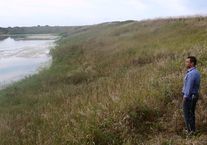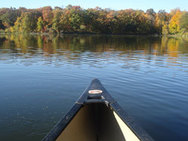 The Lessard-Sams Outdoor Heritage Council voted Sept. 20 to recommend nearly $103 million in funding to the 2014 Legislature for 30-plus proposals. The funding comes from the additional sales tax authorized by the Clean Water, Land and Legacy Amendment. The council had received 56 proposals totaling more than $269 million in response to its call for funding for fiscal year 2015.
Among the proposals recommended for funding are $9.85 million to Pheasants Forever for “Accelerating the Wildlife Management Area Program (phase 6)” and $9.21 million to the Minnesota Board of Water and Soil Resources for the "Reinvest in Minnesota-Wetlands Reserve Program Partnership (phase 4)."
For details of the Sept. 20 meeting and proposals, visit the council website.
|
The Request for Proposal (RFP) process for Watershed Pollutant Load Monitoring Network (WPLMN) grants is open through Oct. 25. Grants under this program are funded by the Minnesota Clean Water Fund. Grant contracts will be competitively awarded and authorized by the Minnesota Pollution Control Agency (MPCA) with up to $950,000 in available funds for this grant round. All applications must be submitted through the SWIFT e-supplier portal and must be received no later than Oct. 25. Proposals received after this deadline will not be considered.
The primary objective of the WPLMN is to obtain spatial and long-term pollutant load information from Minnesota’s rivers and streams. The program utilizes state and federal agencies, universities, and local partners to collect water quality and flow data to calculate pollutant loads. This RFP seeks local partners to collect water quality data and compute pollutant loads at select sites in the Red River, Rainy River and Lake Superior basins in Minnesota. Water quality samples will be collected across a full range of flow conditions with greatest emphasis given to periods of moderate and high flow. Water quality data will be paired with stream flow information to generate estimates of contaminant loading from within a watershed.
The MPCA is responsible for carrying out and overseeing the monitoring of Minnesota’s lakes and streams using Clean Water Legacy funds. WPLMN grants channel these funds to local organizations to assist with these activities. Additional information for this program can be found at the MPCA’s WPLMN webpage.
 Ten state and federal agencies have combined forces to develop a statewide strategy to reduce the amount of nutrients, such as phosphorus and nitrogen, in Minnesota waters.
The goal of the strategy is to get various agencies and groups working together to be more efficient and effective. The strategy goals are a 35 percent reduction in phosphorus and 20 percent reduction in nitrogen by 2025.
A draft strategy is open for public review and comment through Dec. 18. Comments and ideas from all corners are needed to help make it the best plan possible and put it to work.
As a headwater state, Minnesota sends water in three major directions. Surface water leaving Minnesota flows north to Lake Winnipeg, east to Lake Superior, and south to the Gulf of Mexico. Reducing nutrient levels will benefit those downstream waters. The ultimate goal in the gulf is to reduce the level of nutrients coming from the Mississippi River by 45 percent and help repair its low-oxygen “dead zone.”
Excessive amounts of phosphorus and nitrogen can pollute lakes, streams, wetlands, and groundwater. High nutrient levels cause algae blooms and low dissolved oxygen levels as bacteria then consume algae. This is a substantial threat to Minnesota’s waters and aquatic life, as well as downstream waters. Excess nutrients make up 18 percent of Minnesota’s water impairments, and the number is expected to grow in the coming decade.
The “Minnesota Nutrient Reduction Strategy” will help guide state-level programs toward nitrogen and phosphorus reductions within Minnesota water bodies to enhance the health of aquatic life, improve public safety, and increase the recreational potential of Minnesota’s many lakes.
“With funding from the Clean Water Land and Legacy Constitutional Amendment, we have been able to study and quantify the sources of nutrient pollution entering our own waters, and also going downstream,” said Rebecca Flood, MPCA assistant commissioner and chair of the project team. “The path to progress with nutrient reductions is a long one. While we have already made substantial progress in reducing phosphorus, we still have a long ways to go for nitrogen and phosphorus to achieve our in-state and downstream goals.”
Read the full press release for more information.
|
 The MPCA recently released a water quality monitoring and assessment report for the Mississippi River-Twin Cities Watershed that shows poor water quality throughout much of the watershed. Due to the density of industry, housing and roads, lakes and streams in the watershed are showing signs of stress, such as high levels of bacteria and nutrients, eroding stream banks, and loss of sensitive aquatic species.
The Mississippi River-Twin Cities Watershed encompasses a large portion of the metropolitan area of Minneapolis and St. Paul. The watershed is home to more than 1.8 million people across 99 cities, more than 500 species of wildlife and fish, and numerous kinds of aquatic invertebrates.
Highlights of the report:
- Based on water clarity and levels of algae present, 84 of the lakes assessed support aquatic recreation, such as swimming and boating, while 87 lakes do not.
-
Fifty-one lakes had fish with high levels of mercury, PCBs (polychlorinated biphenyls) and/or PFOS (perfluorooctane sulfonate). Because of these levels, fish consumption advisories are recommended for lakes across the watershed.
-
Eight previously impaired lakes have been restored, and are considered healthy.
-
Based on the amounts and types of fish and bugs found, two streams support aquatic life, while 21 do not.
-
Due to high levels of bacteria in assessed streams, only one supports aquatic recreation, while 17 do not.
According to Glenn Skuta, MPCA water monitoring manager, work is already underway to address these issues. “State agencies, watershed management organizations, cities, and local citizens have been working to address these problems to improve and protect the beauty and recreational enjoyment of our lakes and streams in the watershed,” he said. “Dozens of targeted cleanup plans have been completed or are in development to reduce pollution.”
Skuta added that citizens can also help reduce water pollution by cleaning up pet waste, making sure septic systems are up to date, reducing the use of deicers, planting rain gardens or using rain barrels, minimizing application of lawn fertilizers, and cleaning up grass clippings and leaves from paved areas.
Download the full press release, for use on websites or in publications, or link to it, on the MPCA website.
|
 Madelia, the Pheasant Capital of Minnesota, recently bagged several benefits for its community with a habitat project. By converting old sewage treatment ponds to hunting grounds, it saved more than $1 million over the cost of doing the typical cleanup. The town also landed the Minnesota Governor’s Pheasant Hunting Opener for 2013. And the area it created is accessible for non-traditional hunters such as those using wheelchairs.
“In our opinion it was the most cost-effective way to handle the situation. And it’s good wildlife habitat. It was a win-win we felt, for everybody, for the community, for the taxpayers, for the wildlife,” said Jim Pettersen, mayor of Madelia from 2003-2010.
Madelia lies along the Watonwan River in south-central Minnesota. In 1993, the town upgraded its wastewater treatment system to accommodate its growth. While this was good for the river and downstream waters, it left three ponds, covering more than 33 acres, in need of cleanup. The ponds held biosolids — fecal matter and other material — that had settled out of wastewater. Because of the potential to pollute streams and lakes, the MPCA requires the biosolids to be removed and disposed of appropriately.
For other communities with ponds to clean up, Madelia recommends taking careful aim.
“My advice would be look at what needs and interests your city has. And see if there’s a way to leverage interest in your community with the land that’s available in a decommissioned pond, whether it’s a walking path or biking path. Or a recreation area or hunting land. It’s a special opportunity to work with land like this for the benefit of the community,” said City Administrator Dan Madsen.
Read more about this environmental and economical solution on the MPCA website. See details of the Oct. 11-12 pheasant opener on the Madelia website.
|
 Vadnais Lake area watershed
The MPCA is seeking comments through Oct. 15 on a water-quality-improvement report for the Vadnais Lake Area Water Management Organization (VLAWMO). The lakes and stream addressed in this report are located in the northeastern Twin Cities Metropolitan Area and include all or portions of North Oaks, White Bear Lake, Gem Lake, Vadnais Heights, Lino Lakes, and White Bear Township.
The VLAWMO TMDL and Protection Study describes bacteria reductions needed for Lambert Creek and nutrient reductions needed for Gem, East Goose, West Goose, Gilfillan and Wilkinson lakes to meet state water quality standards.
To meet the water quality standard, excess phosphorus will need to be reduced by 24 to 91 percent for the lakes, and bacteria in Lambert Creek will need to be reduced by 61 percent. Sources of phosphorus to the lakes are organic material, such as leaves and grass clippings; fertilizers and sediments transported by stormwater; and the internal loading of phosphorus from lake sediments. The bacteria can come from human, pet and wildlife waste.
Mail comments to Barb Peichel, MPCA, 520 Lafayette Rd. N., St. Paul MN 55155, or email comments to barbara.peichel@state.mn.us. For more information, call Peichel at 651-757-2646.
|
 Lura Lake
Reducing nutrient levels is the focus of a water quality study for Lura Lake in southern Blue Earth and northern Faribault counties. Nutrients such as phosphorus are problematic because they can fuel algal blooms and make lakes less suitable for recreation. The MPCA invites comments on the study through Oct. 22.
The phosphorus standard for Lura Lake is 90 parts per billion, but water monitoring over nine years shows a level of about 191 parts per billion, a violation of the standard designed to ensure that lakes are swimmable and fishable. Meeting the standard will require a significant reduction in nutrients entering the lake from the surrounding land, as well an in-lake treatments.
Compounding the water quality issues are infestations of curly-leaf pondweed and Eurasion milfoil, which are not native to Lura Lake. These two plants tend to crowd out desired plants and emit phosphorus into the water as they die.
Lura Lake covers about 1,300 acres, with a watershed (drainage area) also covering 1,300 acres. About 70 percent of the watershed’s land area is used for agriculture, with the rest used for farmsteads, cabins, forests and a county park. The lake is located near the towns of Amboy, Mapleton and Delevan. Lura Lake is an important resource to local residents, with a lake association promoting conservation and recreation. Fish populations include black bullhead and common carp, along with walleye, northern pike, largemouth bass, blue gill and crappie.
Because no wastewater treatment plant or industry discharges directly to the lake, restoration efforts will include conservation practices on the land draining to the lake as well as in-lake treatments including management of curly-leaf pondweed and Eurasian milfoil.
Mail comments to Paul Davis, MPCA, 12 Civic Center Drive, Suite 2165, Mankato, MN, 56001, or email comments to paul.a.davis@state.mn.us. Davis can be reached by at 507-344-5246 or 800-657-3864.
Background on TMDLs
TMDL reports are part of a nationwide effort under the federal Clean Water Act to identify and clean up pollution in streams, rivers and lakes. A TMDL report is a scientific study that calculates the maximum amount of a pollutant a water body can receive, known as its "loading capacity," without exceeding water quality standards.
Written comments must include a statement of your interest in the report; a statement of the action you wish the MPCA to take, including specific references to sections of the draft report you believe should be changed; and specific reasons for your position.
After receiving public comments, the MPCA will revise the draft TMDL reports and submit them to the U.S. Environmental Protection Agency (EPA) for approval. Following EPA approval, the MPCA will work with local partners to develop plans to reduce pollutants in the waters.
|
The EPA recently approved the Total Maximum Daily Load (TMDL) report for the North Fork and Lower Crow River in central Minnesota. The TMDL report addresses impairments for dissolved oxygen, turbidity and bacteria. The project area starts at Koronis Lake in Stearns County and continues to the confluence of the Mississippi River near Dayton, Minn. The Crow River Organization of Water (CROW) is an active partner in this TMDL.
The Minnesota Erosion Control Association (MECA) will hold an Erosion and Sediment Control Field Seminar Thursday, Nov. 7, in Cottage Grove, Minn. This event will showcase the latest erosion and sediment control products, provide demonstrations and examples of practices installed, and offer a question-and-answer session with experts. The cost is $40 for MECA members and $45 for non-members. Participants may choose from one of two sessions: 9-11 a.m. and 1-3 p.m. This event is sponsored by MECA, South Washington Watershed District and East-Metro Water Resource Education Program. Registration is available on the MECA website.
Catch MECA’s latest educational video, “Best Management Practices and Housekeeping on a Construction Site” online.
The Watershed Professionals Network for the Minnesota River Basin will meet Tuesday, Nov. 19, 10 a.m.-3 p.m., at the New Ulm Pizza Ranch.
Topics so far include:
- Minnesota River Integrated Watershed Study (USACE) - Kate Franz of the Environmental Quality Board
- Nitrogen: Statewide nitrogen strategy by Dave Wall and Wayne Anderson of the MPCA; Minnesota Dept. of Agriculture nitrogen fertilizer management plan; and an interagency clean water performance report
- Updates from watershed organizations
For more information, contact Forrest Peterson of the MPCA at 320-441-6972.
The Minnesota Association of Soil and Water Conservation Districts (MASWCD) 77th Annual Meeting and Trade Show will take place on Dec. 1-3 at the Double Tree by Hilton Hotel in Bloomington, Minn. The annual meeting is hosted by the MASWCD Southeast Area 7 Soil & Water Conservation Districts: Dodge, Fillmore, Freeborn, Goodhue, Mower, Olmsted, Rice, Root River, Steele, Wabasha, and Winona. The MPCA is registered to participate in the trade show, with information about various programs and projects such as the statewide nutrient reduction strategy, feedlots, on-site sewer systems, and citizen water monitoring. For more information about the event contact the MASWCD office at 651-690-9028 or visit www.maswcd.org.
“Alliant tests Cedar River for coal plant pollutants” in the Rochester Post-Bulletin
“Potato grower's purchase of forestland draws scrutiny” on Minnesota Public Radio
"Minnesota sets goals for fixing Gulf of Mexico dead zone" in the StarTribune
“Iron Range mine could pollute water for up to 500 years” in the StarTribune
“Rescuing a treasured urban lake” on the MPCA website
"Sister Lakes: Pepin in Minnesota and Liangzi in China" on the MPCA website
|